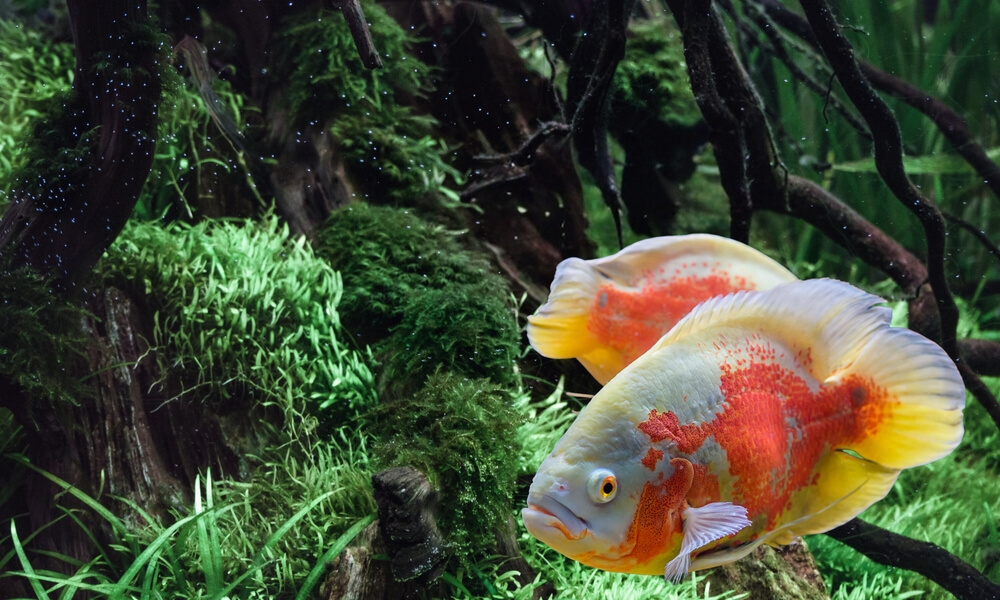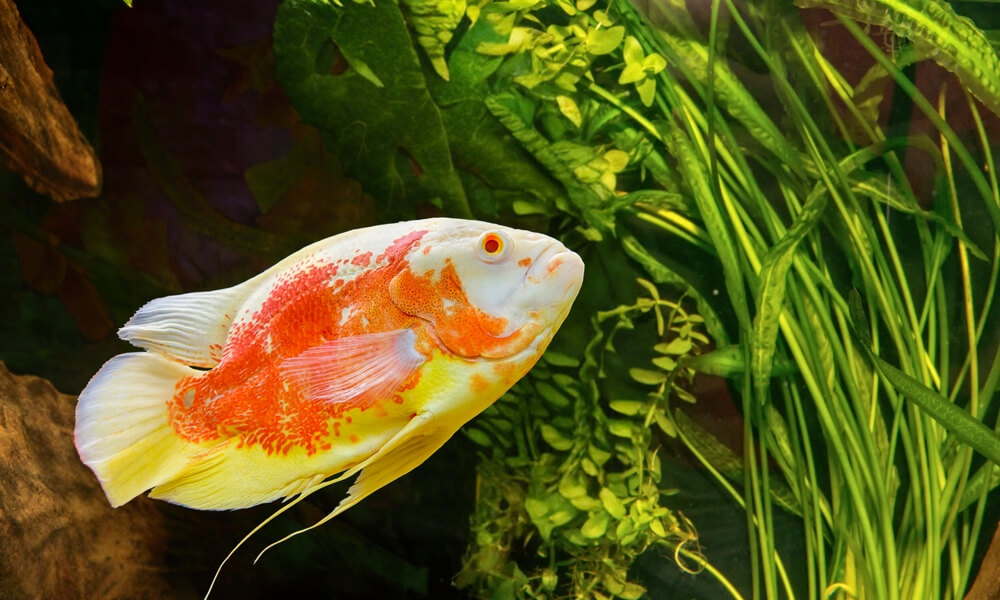
Oscar fish, known for their vibrant colors and engaging personalities, make a captivating addition to any aquarium. However, caring for these unique creatures requires specific knowledge and attention to detail.
Understanding Their Unique Characteristics Oscar Fish
Oscar fish, also known as Oscar cichlids, are a popular choice among aquarium enthusiasts due to their vibrant colors and engaging personalities. Native to South America, these tropical fish are known for their intelligence and can even recognize their owners.
When it comes to oscar fish care, it’s essential to understand their specific needs. Oscars require a spacious tank, ideally 55 gallons or larger, as they can grow up to 12-14 inches in length. Water quality is crucial; maintaining a stable temperature between 74-81°F and a pH level of 6.0-8.0 will help ensure your oscar thrives.
Diet is another important aspect of caring for oscar cichlids. They are omnivores and benefit from a varied diet that includes high-quality pellets, live or frozen foods like brine shrimp and bloodworms, as well as occasional vegetables such as peas.
In addition to proper nutrition and water conditions, providing an enriched environment with hiding spots like rocks and driftwood will help reduce stress for your oscar fish. Regular tank maintenance is also key; frequent water changes and monitoring of ammonia levels will keep your aquarium in optimal condition.
By understanding these unique characteristics and requirements of oscar fish care, you can create a healthy habitat where your oscar cichlid can flourish for years to come.
Setting Up the Perfect Habitat for Your Oscar Fish

Setting up the perfect habitat for your Oscar fish is essential to ensure their health and happiness. One of the first considerations is the oscar fish tank setup. Oscars are large, active fish that require ample space to thrive. The best tank size for oscar fish is at least 55 gallons for a single adult, with an additional 20-30 gallons for each additional Oscar.
Aquarium decorations play a crucial role in creating a stimulating environment. While Oscars are known to rearrange their surroundings, providing sturdy decorations like rocks, driftwood, and robust plants can help simulate their natural habitat. Be cautious with delicate or sharp objects as these could harm your fish.
Water conditions for oscars must be carefully maintained. They prefer slightly acidic to neutral water (pH 6-8) and temperatures between 74-81°F (23-27°C). Regular water changes and efficient filtration systems are vital to keep ammonia and nitrate levels low, ensuring a healthy environment.
By focusing on these key elements you can create an ideal habitat that promotes the well-being of your Oscar fish.
Diet and Nutrition Tips for Oscar Fish
Oscar fish are known for their vibrant colors and engaging personalities, but maintaining their health requires a proper diet. Understanding the oscar fish diet is crucial for ensuring your aquatic pet thrives in its environment. So, what should you feed your oscar fish to keep them healthy and happy?
Oscars are omnivores, meaning they consume both plant and animal matter. The best food for oscars includes a mix of high-quality pellets or flakes specifically formulated for cichlids, along with live or frozen foods such as brine shrimp, bloodworms, and small feeder fish. Incorporating vegetables like peas and spinach can also provide essential nutrients.
To establish an effective feeding schedule for oscars, it’s recommended to feed adult oscars once or twice a day. Juvenile oscars may require more frequent feedings due to their rapid growth rates. Be mindful of overfeeding; uneaten food can pollute the tank water, leading to health issues.
By providing a balanced diet that includes both commercial foods and natural treats, you can ensure your oscar fish remains vibrant and active. Regularly monitoring their eating habits will help you adjust their diet as needed to maintain optimal health.
Key Parameters and Regular Maintenance for Oscar Fish
Ensuring optimal aquarium water quality is crucial for the health and well-being of your aquatic pets. One of the primary parameters to monitor is ammonia levels in the aquarium. Ammonia, produced from fish waste and uneaten food, can be toxic to fish even at low concentrations. Regular testing and immediate action, such as partial water changes or using ammonia-neutralizing products, are essential to keep these levels in check.
Another critical factor is pH levels, especially if you are keeping species like oscar fish that thrive in specific conditions. For oscar fish, maintaining a pH level between 6.0 and 8.0 is ideal. Fluctuations outside this range can cause stress and health issues for your fish.
A consistent water change schedule is fundamental to maintaining overall water quality. Typically, a 10-20% water change every one to two weeks helps remove toxins like nitrates and replenishes essential minerals that get depleted over time.
By regularly monitoring these key parameters and adhering to a strict water change schedule, you can ensure a healthy environment for your aquarium inhabitants.
Common Health Issues in Oscar Fish and How to Treat Them
Oscar fish are a popular choice among aquarium enthusiasts due to their vibrant colors and engaging personalities. However, like all pets, they can be susceptible to various health issues. Understanding common ailments in oscars and knowing how to treat them is crucial for maintaining their well-being.
One of the most prevalent oscar fish diseases is Ich, also known as white spot disease. It manifests as small white spots on the fish’s body and fins. Treating sick oscar fish with Ich involves raising the water temperature gradually to around 86°F and adding aquarium salt or specific Ich treatment medications available at pet stores.
Hole-in-the-head disease is another common ailment in oscars, characterized by pitting or lesions on the head and lateral line. This condition often results from poor water quality or nutritional deficiencies. To address this issue, ensure your tank’s water parameters are optimal and provide a balanced diet rich in vitamins and minerals.
Fin rot is also frequently observed in oscar fish. Signs of unhealthy oscar fish with fin rot include frayed or discolored fins. Improving water quality through regular changes and using antibacterial treatments can help cure this condition.
Lastly, internal parasites can affect oscars, leading to symptoms such as weight loss, lethargy, and abnormal feces. Treating these parasites typically involves administering anti-parasitic medications designed for aquarium use.
By staying vigilant for these signs of unhealthy oscar fish and promptly addressing any issues that arise, you can ensure your aquatic pets remain healthy and vibrant for years to come.
The Social Side of Oscars (Behavior and Tank Mates Compatibility)
Oscar fish are known for their distinctive personalities and complex behavior patterns, making them a popular choice among aquarists. Understanding oscar fish behavior patterns is crucial for maintaining a harmonious aquarium environment. These fish are intelligent and can exhibit a range of behaviors from playful to aggressive, often depending on their surroundings and tank mates.
One key aspect to consider is the aggressive behavior in oscars, which can sometimes pose challenges when selecting suitable tank mates. Oscars are territorial by nature, especially during breeding periods, which can lead to conflicts if not properly managed. It’s essential to provide ample space and hiding spots within the tank to mitigate aggression.
When it comes to choosing suitable tank mates for oscars, it’s important to select species that can coexist peacefully with them. Ideal companions include larger cichlids like Jack Dempseys or Severums, as well as robust catfish species such as Plecos or Synodontis. These choices tend to match the oscar’s temperament and size, reducing the likelihood of hostile interactions.
While oscar fish bring vibrant life and intriguing behaviors to an aquarium, careful consideration of their social dynamics is essential. By understanding their behavior patterns and thoughtfully selecting compatible tank mates, aquarists can create a balanced and thriving aquatic community.
A Step-by-Step Guide to Successful Breeding Oscars
Breeding Oscar cichlids can be a rewarding experience for both novice and experienced aquarists. These vibrant and intelligent fish are known for their unique spawning habits and parental care. To successfully breed Oscars, it’s essential to understand their specific needs and behaviors. Here’s a comprehensive guide on how to breed Oscars effectively.
First, ensure you have a compatible pair of Oscar cichlids. It’s often best to start with a group of juveniles and allow them to pair off naturally as they mature. Once you’ve identified a bonded pair, provide them with an appropriate breeding environment. A spacious tank of at least 75 gallons is recommended, with plenty of flat surfaces like rocks or slate where they can lay their eggs.
Maintaining optimal water conditions is crucial for breeding success. Keep the water temperature between 78-82°F (25-28°C) and ensure the pH level is stable around 6.5-7.0. Regular water changes are essential to keep the environment clean and conducive for spawning.
When ready to spawn, you’ll notice changes in the behavior of your oscillated cichlids. They may become more territorial and start cleaning potential spawning sites vigorously. The female will lay hundreds of eggs on the chosen surface, which the male will then fertilize.
After fertilization, both parents will guard the eggs diligently, fanning them with their fins to ensure proper oxygenation and removing any unfertilized or fungus-infected eggs. The eggs typically hatch within 3-4 days, after which the fry will remain under parental care until they are free-swimming.
Feeding high-quality foods such as live or frozen brine shrimp can enhance the health and vitality of both parents and fry during this period.
By following these steps closely, you can increase your chances of successfully breeding Oscar cichlids while enjoying watching these fascinating fish exhibit their natural spawning behaviors.



